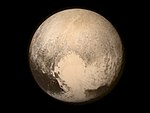| Discovery[1][2][3] | |
|---|---|
| Discovered by | Pan-STARRS 1 (first observered) |
| Discovery site | Haleakala Obs. |
| Discovery date | 6 December 2015 |
| Designations | |
| 2015 XY261 | |
| Apollo · NEO[1][2] | |
| Orbital characteristics[1] | |
| Epoch 23 March 2018 (JD 2458200.5) | |
| Uncertainty parameter 5 | |
| Observation arc | 0.025 yr (9 days) |
| Aphelion | 2.1890 AU |
| Perihelion | 0.8003177 AU |
| 1.4945093 AU | |
| Eccentricity | 0.4644947 |
| 1.83 yr (667 days) | |
| 62.24896° | |
| 0° 32m 22.041s / day | |
| Inclination | 1.59013° |
| 86.91527° | |
| 61.94406° | |
| Earth MOID | 0.00184 AU (0.72 LD) |
| Physical characteristics | |
| Dimensions | 9.7–22 meters[4] |
| 27.2[1] | |
2015 XY261 (also written 2015 XY261) is an Apollo near-Earth asteroid[2] that is also a Mars crosser. It is roughly 10–22 meters in diameter and passed less than 1 lunar distance, 0.0025696 AU (384,410 km; 238,860 mi) from Earth on 15 December 2015.[5]
2015 flyby[edit]
This small dim asteroid approached Earth in opposition, having an elongation from the Sun of over 160 degrees from mid November 2015. However, due to its absolute magnitude even though it had a very low phase angle during the approach it was too dim for contemporary telescopes to spot it so early, as it was significantly fainter than apparent magnitude 23.[6] However it got brighter as it approached and a few weeks later, on 6 December 2015 it was spotted by Pan-STARRS at an apparent magnitude of 21.5 using a 1.8-meter (71 in) Ritchey–Chrétien telescope.[3]
On 15 December 2015 at 13:52 UT, the asteroid passed 0.0019277 AU (288,380 km; 179,190 mi) from the Earth and three and a half hours later at 17:17 UT passed 0.00354 AU (530,000 km; 329,000 mi) from the Moon.[5]
This flyby is notable because the discovery was 9 days prior to closest approach. This is one of the earliest discoveries of an asteroid during approach. Discounting cataloged objects which were discovered during previous orbits, most asteroids are discovered with little or no warning. 2015 XY261 was the only asteroid to pass within 1 LD of Earth in 2015 that was discovered more than a week before closest approach. See List of asteroid close approaches to Earth in 2015.
References[edit]
- ^ a b c d "JPL Small-Body Database Browser: (2015 XY261)" (2015-01-29 last obs.). Jet Propulsion Laboratory. Retrieved 28 July 2018.
- ^ a b c "2015 XY261". Minor Planet Center. Retrieved 28 July 2018.
- ^ a b "MPEC 2015-X153: 2015 XY261". IAU Minor Planet Center. 30 January 2015. Retrieved 28 July 2018. (K15Bp3P)
- ^ "Absolute Magnitude (H)". NASA/JPL. Archived from the original on 2 March 2001. Retrieved 28 July 2018.
- ^ a b "JPL Close-Approach Data: (2015 XY261)" (last observation: 2015-01-29; arc: 10 days). Retrieved 28 July 2018.
- ^ "2015XY261 Ephemerides for 15 January 2015 through 1 February 2015". NEODyS (Near Earth Objects – Dynamic Site). Retrieved 28 July 2018.
External links[edit]
- 2015 XY261 at NeoDyS-2, Near Earth Objects—Dynamic Site
- 2015 XY261 at ESA–space situational awareness
- 2015 XY261 at the JPL Small-Body Database


